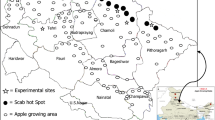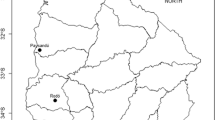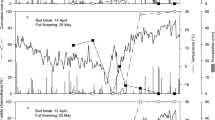Abstract
Apple scab caused by Venturia inaequalis is the most destructive apple disease worldwide. To manage apple scab in Uruguay, protectant fungicides are applied in anticipation of each rain event during ascospore discharge period. To optimize fungicide application, we studied the beginning and the end of ascospore discharge period and its behavior during nighttime and successive rain days, in natural and artificial conditions. Results showed that V. inaequalis ascospore discharge occurs in a period of 2 months, starting in the green tip stage and ending in early November, around 40 days before the usual warning system communication. Mature ascospores are released immediately after a rain event begins, regardless whether it is day- or nighttime. During consecutive days or nights of rain, successive discharges occur during 3 and eventually 4 days, with the greatest discharge occurring in the first 2 days. This finding suggests that the fungicide applications could be suspended earlier than usual and that strategic irrigations previously to forecast could be implemented to manage apple scab. However, field trials should be conducted to further validate this finding.





Similar content being viewed by others
Data availability
All data generated or analyzed during this study are included in this published article and in a supplementary information file. In addition, the file with the data is available at https://drive.google.com/file/d/1NdYFTaCNhPbm85vSU_eYYKig89-74SsP/view?usp=sharing
References
Alaniz S, Leoni C, Bentancur O, Mondino P (2014) Elimination of summer fungicide sprays for apple scab (Venturia inaequalis) management in Uruguay. Scientia Horticulturae 165:331–335
Aylor DE (1992) Release of Venturia inaequalis ascospores during unsteady rain: relationship to spore transport and deposition. Phytopathology 82:532
Aylor DE (1993) Relative collection efficiency of Rotorod and Burkard spore samplers for airborne Venturia inaequalis ascospores. Phytopathology 83:1116–1119
Aylor DE, Sutton TB (1992) Relative collection efficiency of Rotorod and Burkard spore samplers for airborne Venturia inaequalis ascospores. Phytopathology 82:532–540
Brook PJ (1966) The ascospore production season of Venturia inaequalis (Cke.) Wint., the apple black spot fungus. New Zealand Journal of Agricultural Research 9:1064–1069
Brook PJ (1969) Effects of light, temperature, and moisture on release of ascospores by Venturia inaequalis (Cke.) Wint. New Zealand Journal of Agricultural Research 12:214–227
Brook PJ (1976) Seasonal pattern of maturation of Venturia inaequalis ascospores in New Zealand. New Zealand Journal of Agricultural Research Res 19:103–109
Carbone MJ, Alaniz S, Mondino P (2019) La resistencia a fungicidas como factor determinante de las estrategias de manejo de la Sarna del Manzano. In: INIA (ed) Seminario de Actualización Técnica en Frutales de Pepita. Serie Actividades de Difusión No 792. INIA, Las Brujas, pp 17–27
Gadoury DM, Mac Hardy WE (1982a) Preparation and interpretation of squash mounts of pseudothecia of Venturia inaequalis. Phytopathology 72:92–95
Gadoury DM, Mac Hardy WE (1982b) A model to estimate the maturity of ascospores of Venturia inaequalis. Phytopathology 72:901
Gadoury DM, Mac Hardy WE (1983) A 7 day recording volumetric spore trap. Phytopathology 73:1526–1531
Gadoury DM, Mac Hardy WE (1986) Forecasting ascospore dose of Venturia inaequalis in commercial apple orchards. Phytopathology 76:112–118
Gadoury DM, Rosenberger DA, Barnard J, Mac Hardy WE (1992a) Variation and error in estimates of ascospore maturity and discharge derived from examination of crushed pseudothecia of Venturia inaequalis. Plant Disease 76:717
Gadoury DM, Rosenberger DA, Wilcox WF, MacHardy WE, Berkett LP (1992b) Disparity between morphological maturity of ascospores and physiological maturity of asci in Venturia inaequalis. Plant Disease 76:277
Gadoury DM, Stensvand A, Seem RC (1998) Influence of light, relative humidity, and maturity of populations on discharge of ascospores of Venturia inaequalis. Phytopathology 88:902–909
Gadoury DM, Seem RC, MacHardy WE, Wilcox WF, Rosenberger DA, Stensvand A (2004) A comparison of methods used to estimate the maturity and release of ascospores of Venturia inaequalis. Plant Disease 88:869–874
García S, Moscardi C (1975) Sarna del manzano. Sintomatologia y ciclo biologico. In: CIAAB (ed) Hoja de divulgación No 23. CIAAB, Las Brujas, pp 1–5
Hirst JM (1952) An automatic volumetric spore trap. Annals of Applied Biology 39:257–265
Holb IJ, Heijne B, Withagen JCM, Jeger MJ (2004) Dispersal of Venturia inaequalis ascospores and disease gradients from a defined inoculum source. Journal of Phytopathology 152:639–646
Korsgaard M (2014) Strategic irrigation can reduce apple scab (Venturia inaequalis (Cke.) Wint.). In: proceedings of the 16th international conference on organic fruit-growing. Pp 52–58
Korsgaard M (2016) Effect of strategic irrigation on infection of apple scab (Venturia inaequalis). In: FOO EV (ed) Proceedings of the 17th lnternational conference on organic fruit-growing. Hohenheim, Germany, pp 45–52
Mac Hardy WE, Gadoury DM (1986) Patterns of ascospore discharge by Venturia inaequalis. Phytopathology 76:985–990
MGAP (2018) Normas de Producción Integrada para manzana. Available at: https://www.gub.uy/ministerio-ganaderia-agricultura-pesca/comunicacion/publicaciones/normas-produccion-integrada-para-manzana-2018. Accessed on March 09, 2021
Mills WD, LaPlante AA (1951) Diseases and insects in the orchard. In: Cornell Exttension bulletin. 711. Cornell University, Cornell, pp 21–27
Mondino P, Alaniz S (2009) Manejo integrado de la sarna del manzano. In: Stadnik M (ed) Manejo Integrado de doenças da macieira, 1st edn. CCA-UFSC, Florianópolis, pp 35–43
Mondino P, Casanova L, Celio A, Bentancur O, Leoni C, Alaniz S (2015) Sensitivity of Venturia inaequalis to trifloxystrobin and difenoconazole in Uruguay. Journal of Phytopathology 163:1–10
Moscardi C, Garcia S (1975) Principales enfermedades de los frutales de hoja caduca. In: Hoja de divulgación No15. CIAAB, Las Brujas, pp 1–4
Rossi V, Ponti I, Marinelli M, Giosuè1 S, Bugiani R (2000) A new model estimating the seasonal pattern of air-borne ascospores of Venturia inaequalis (Cooke) Wint. in relation to weather conditions. Journal of Plant Pathology 82:111–118
Rossi V, Ponti I, Marinelli M, Giosuè S, Bugiani R (2001) Environmental factors influencing the dispersal of Venturia inaequalis in the orchard air. Journal of Phytopathology 149:11–19
Schwabe WFS (1979) Changes in scab susceptibility of apple leaves is influenced by age. Phytophylactica 11:53–56
Stensvand A, Amundsen T, Semb L, Gadoury DM, Seem RC (1998) Discharge and dissemination of ascospores by Venturia inaequalis during dew. Plant Disease 82:761–764
Szkolnik M (1969) Maturation and discharge of ascospores of Venturia inaequalis. Plant Disease Report 53:534–537
Warner J, Braun PG (1992) Discharge of Venturia inaequalis ascospores during daytime and nighttime wetting periods in Ontario and Nova Scotia. Canadian Journal of Plant Pathology 14:315–321
Acknowledgements
This work was supported by the funding agency ANII (Fondo María Viñas — FMV 2 2011 1 7253) from Uruguay. The authors are grateful to the farmers for providing the orchards where the trials were conducted.
Author information
Authors and Affiliations
Contributions
EM performed the experimental work and the analyses of data and wrote the draft of the manuscript. PM conceived and designed study; SA and PM supervised the work, analysis, and interpretation. PM and SA perform the writing and critical review of the manuscript. All the authors read and approved the final manuscript.
Corresponding author
Ethics declarations
Conflict of interest
The authors declare no competing interests.
Additional information
Publisher’s note
Springer Nature remains neutral with regard to jurisdictional claims in published maps and institutional affiliations.
Rights and permissions
About this article
Cite this article
Martínez, É., Alaniz, S. & Mondino, P. Release dynamics of Venturia inaequalis ascospores in Uruguay. Trop. plant pathol. 46, 414–421 (2021). https://doi.org/10.1007/s40858-021-00434-4
Received:
Accepted:
Published:
Issue Date:
DOI: https://doi.org/10.1007/s40858-021-00434-4




